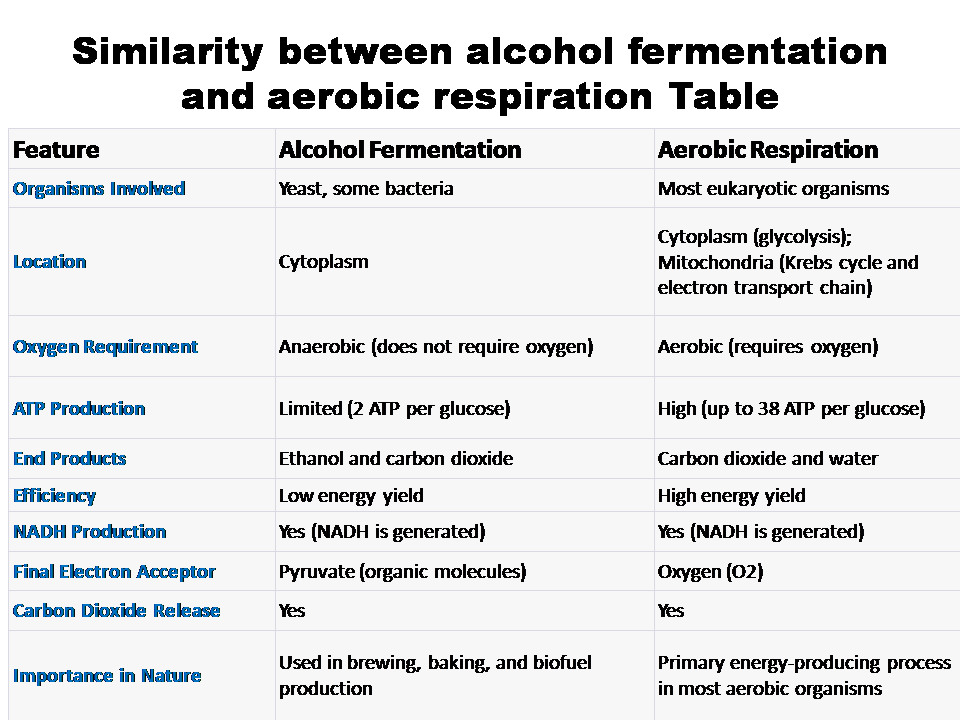Here you will learn about the similarity between alcohol fermentation and aerobic respiration.

When we think of alcohol fermentation and aerobic respiration, we often associate them with vastly different processes and outcomes. One is the source of alcoholic beverages, while the other is essential for the energy production of most living organisms.
However, beneath their apparent differences lies a fascinating similarity: both alcohol fermentation and aerobic respiration are metabolic pathways that involve the conversion of one type of molecule into another, with the ultimate goal of generating energy.
Alcohol fermentation and aerobic respiration show similarities in these conditions.
- Cellular energy production
- Common Intermediates
- An aerobic Condition
Cellular Energy Production
The fundamental similarity between alcohol fermentation and aerobic respiration is that they both serve as a means for cells to generate energy in the form of adenosine triphosphate (ATP). ATP is the primary energy currency in cells, responsible for powering various cellular processes.
In aerobic respiration, which takes place in the presence of oxygen, glucose is broken down through a series of complex chemical reactions. This breakdown yields a substantial amount of ATP, making it the most efficient process for energy production in cells.
The equation for aerobic respiration is:
C6H12O6 (glucose) + 6 O2 (oxygen) -> 6 CO2 (carbon dioxide) + 6 H2O (water) + ATP
On the other hand, alcohol fermentation is an anaerobic process, occurring in the absence of oxygen. During alcohol fermentation, glucose is partially metabolized into ethanol (alcohol) and carbon dioxide, with a smaller amount of ATP being produced compared to aerobic respiration:
C6H12O6 (glucose) -> 2 C2H5OH (ethanol) + 2 CO2 (carbon dioxide) + ATP
Common Intermediates
Another notable similarity between alcohol fermentation and aerobic respiration is the involvement of common intermediates in their respective pathways. One such intermediate is pyruvate. In both processes, glucose is initially broken down into pyruvate through a series of enzymatic reactions.
In aerobic respiration, pyruvate is further oxidized in the mitochondria. It produce more ATP through the citric acid cycle (Krebs cycle) and the electron transport chain. During alcohol fermentation, pyruvate is converted into ethanol and carbon dioxide in the absence of oxygen, with the generation of a small amount of ATP.
This shared intermediate, pyruvate, underscores the evolutionary connection between these metabolic pathways, suggesting that they share a common ancestral pathway that has diverged over time to accommodate different environmental conditions and cellular needs.
Anaerobic Conditions
Alcohol fermentation and aerobic respiration represent two different strategies that cells use to generate energy when faced with distinct environmental conditions.
Alcohol fermentation occurs in anaerobic environments where oxygen is scarce or entirely absent. This is common in microorganisms like yeast that thrive in environments such as the bottom of fermentation tanks or the interiors of dough during breadmaking.
On the other hand, aerobic respiration occurs in the presence of oxygen, which is abundant in aerobic organisms like humans and most animals. This process enables cells to extract more energy from glucose, making it the preferred choice when oxygen is available.